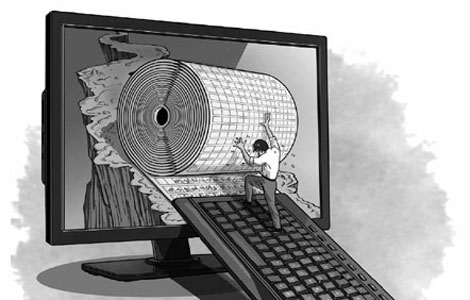US Sinophile traces the evolution of Chinese words
Updated: 2013-10-08 08:01
By Zhang Lei (China Daily)
|
||||||||
Richard Sears has been devoted to tracing the original forms of Chinese characters on his website for the past 20 years. Provided to China Daily

Online etymology database helps netizens learn origins of language
For 20 years Richard Sears has been devoted to making the etymological information of Chinese characters available online for people to trace them back to their original form, when they were first carved or written on bamboo slips or silk more than 2,000 years ago.
Although the 62-year-old launched his website in 2002, it elicited little response from Chinese netizens until last year, when two Chinese newspapers published his story.
That led to Chinese bloggers praising his work, as well as bemoaning the fact government-funded cultural promotion agencies had been unable to create such a good website for people fascinated by Chinese characters. Each character on his website comes with three former variations - the seal script, bronze inscriptional and oracle bone inscription - and an illustrated guide on its etymology.
Despite his recent success, Sears, who is from the United States but lives in Beijing, said there is still much work to be done, "especially with Chinese characters that are not easy to trace their former shape, and where there are contradictions in different books".
"I'm also thinking about scanning cursive Chinese characters and indexing them," he said.
Over two decades, Sears has compiled a database of more than 96,000 archaic Chinese characters using three ancient books: Shuo Wen Jiezi, Xu Jia Gu Wen Bian and Jin Wen Bian.
With alternate seal characters from Liu Shu Tong, he presents all the seal forms that are available. For example, a character has 16 seal scripts, 20 bronze and 81 oracle variations.
The website has complete etymological analysis of the 6,552 most common modern Chinese characters, as well as a Mandarin, Taiwanese and Cantonese speech and phonetic database for each character.
"The Chinese saying goes 'live until you are old, learn until you are old'. It means we should be learning all our lives," Sears said. "My main interest is languages. I am fluent in Chinese, and have studied several other languages with varying success.
"While scanning these ancient characters, I've found that 90 percent can be traced back to their etymology, but for 50 percent, different scholars have different opinions. The other 10 percent, no one knows their original shape."
Sears has completed his work almost entirely alone.
"By indexing ancient characters, I've gradually become familiar with the evolution of a character from its original shape, which is closer to the Chinese language's initial ideogram principle. That is easy for me as a learner to understand the original meaning behind each character," he said. "For example, suddenly I can realize why a particular character has those kinds of strokes.
"With the advantage of computerized etymology, I can do all kinds of Chinese character and text analysis, and this ongoing online research project can help me better identify the errors or discrepancies, and they can be corrected much easier in a systematic way."
Charmed by the Chinese language during his first visit to Taiwan in 1972 when he was just 22, Sears decided to learn it. During his studies, he said he felt daunted by the prospect of learning to write around 5,000 characters and 60,000 character combinations, many of which have no apparent logic in their stroke formations.
He said the lack of even a single book in English that could explain the etymology spurred him to create his own website.
Yet, it was not until a life-or-death incident that he finally started the work.
"In 1994, I had a severe heart attack . . . that nearly took my life. At that moment I had this urge to realize my dream of setting up the website. What if there was only a year for me to live?" he recalled. "Fortunately, after successful bypass surgery, I survived and began to digitalize Chinese characters by hiring people to scan them for me."
The costs involved in realizing the project - including books, wages and travel - were not easy. In 2002, he ran out of money and had to sell his house to move into a one-room apartment. The project has so far cost him $300,000 and his marriage, he said.
Last year he moved to Tianjin and later secured work at Beijing Normal University as a physics teacher.
"To me as a foreigner, these symbols mean an exoticism and a different cultural heritage that is beyond the boundaries of nationality."
- Get up close with anime characters
- Taipei hosts Chinese character art festival
- China sets down standards for Chinese characters
- Chinese characters under threat in digital age
- 'Change' chosen as Chinese character of 2012 in Malaysia
- Chinese Character of the Year named
- Write or wrong: Children struggle with characters
Most Viewed
Editor's Picks

|

|

|

|

|

|
Today's Top News
Kerry says US will work to end fiscal crisis
Trending news across China
Americans to name panda cubs at Atlanta zoo
US investors say they are less bullish on China
Obama remarks show China high on agenda
Hong Kong benefits from rising renminbi
WB chief praises China for reforms
China is a major contributor to global growth
US Weekly

|

|















